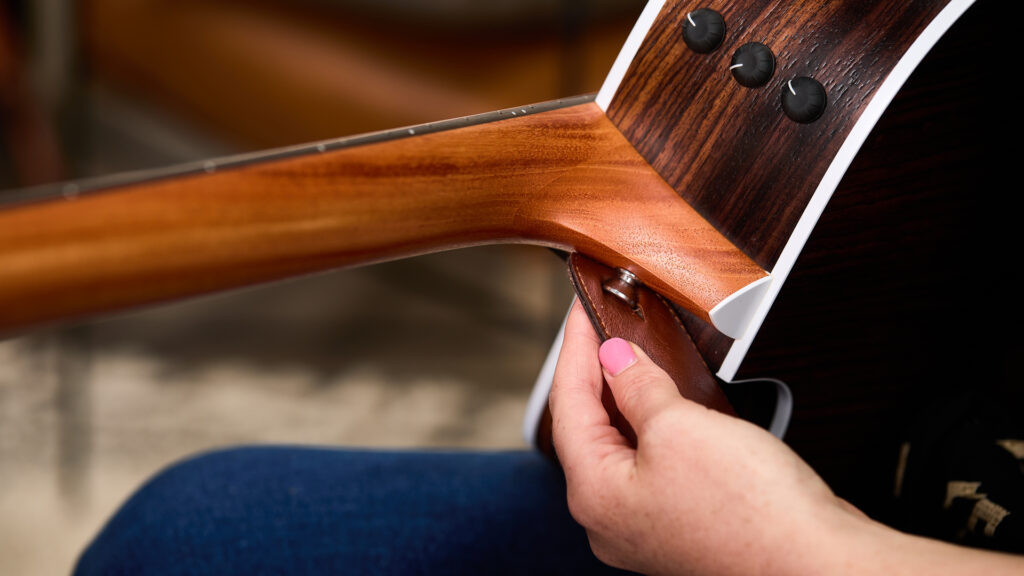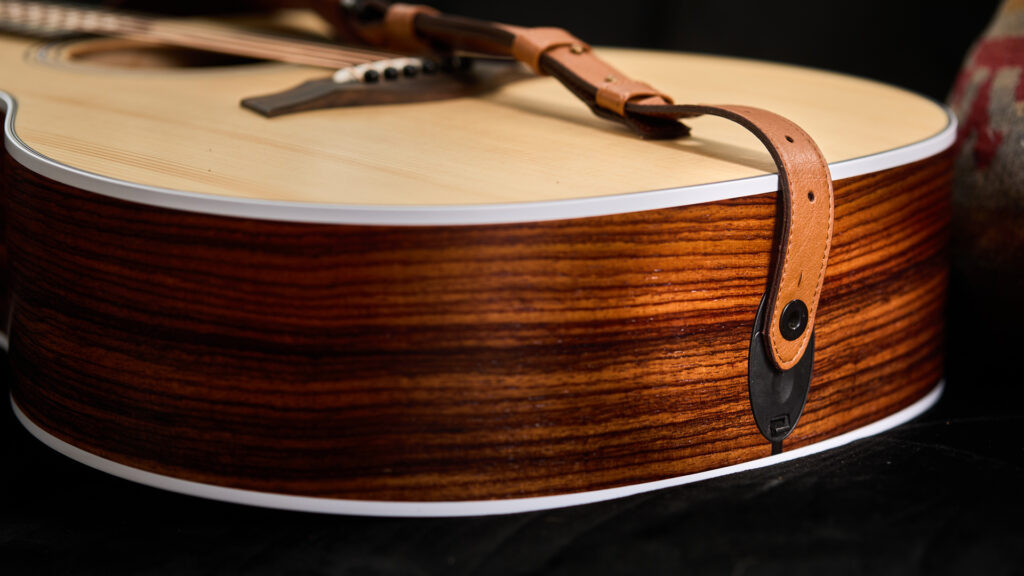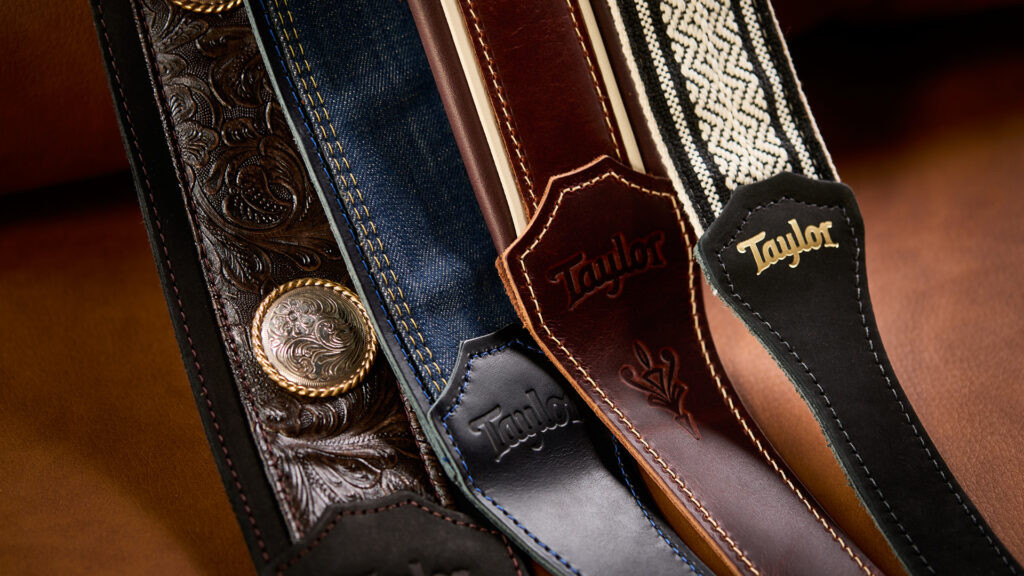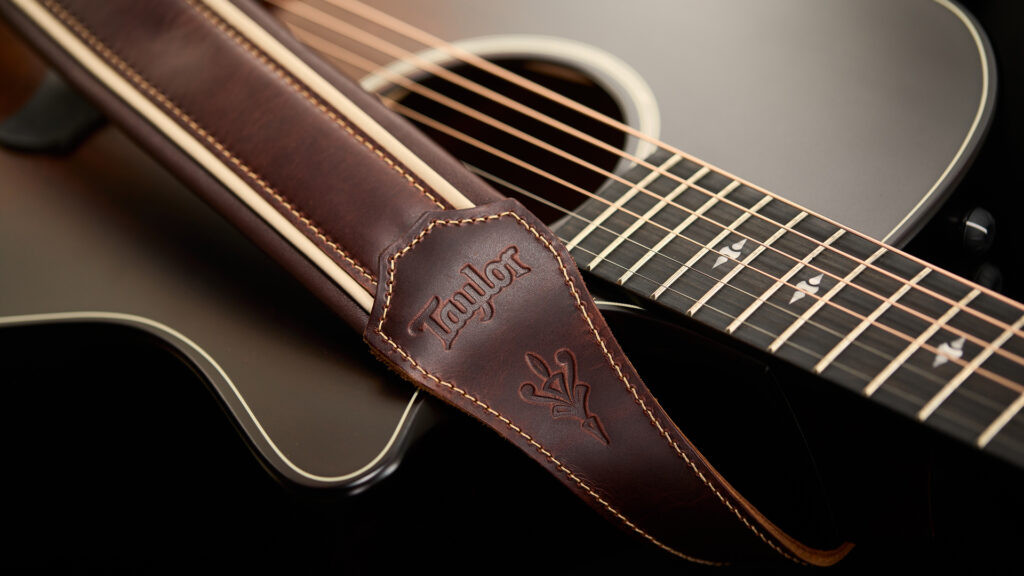Putting on an acoustic guitar strap correctly allows you to play comfortably while standing, adding freedom and expression to your performance, and at guitarplayers.net, we understand the importance of a secure and stylish strap. This guide helps you properly attach your guitar strap, ensuring comfortable and ergonomic music-making. Learn to choose the best strap for your needs and play with confidence!
1. What Is The Best Way To Attach A Strap To A Guitar With Two Pins?
The best way to attach a strap to a guitar with two pins involves a few simple steps to ensure a secure fit. Strap pins, or strap buttons, are typically found on electric guitars and basses, as well as many acoustic guitars, and they act as the anchor points for your strap.
Here’s how to do it:
- Orient the Strap: Determine which end of the strap is the top and which is the bottom. Usually, the end with the adjustable buckle goes towards the bottom pin of the guitar. Straps with logos or designs often attach to the pin near the neck.
- Attach the Strap to the Bottom Button: Place the strap over the bottom strap button, ensuring it fits snugly.
- Attach the Strap to the Top Button: Take the other end of the strap and insert the remaining strap pin through the hole or slit.
- Test the Security: Tug lightly on each end of the strap to make sure the installation is snug and secure.
Even with two strap pins, some guitarists prefer the feeling of a one-pin setup, allowing for experimentation to find the best fit.
The placement of these pins can vary; one is usually at the bottom end of the guitar, and the other is either on the top shoulder of the body or behind the neck where it meets the body. According to research from Berklee College of Music in July 2025, a secure strap installation is crucial for preventing accidental drops and ensuring a comfortable playing experience, allowing guitarists to focus on their performance without worrying about the safety of their instrument.
2. How Can You Attach A Guitar Strap To An Acoustic Guitar With Only One Pin?
Attaching a guitar strap to an acoustic guitar with only one pin is straightforward, requiring no drilling and maintaining the instrument’s integrity. Many acoustic guitars come with just one strap pin located at the bottom of the instrument.
Here’s the method:
- Secure the Bottom: Attach one end of the strap to the strap pin at the bottom of the guitar.
- Headstock Attachment: Bring the other end of the strap up toward the headstock. Since there’s no strap button there, you’ll need to use a lace or a strap adapter to secure it. Many straps include a lace for this purpose. A strap adapter like the Taylor Strap Adapter can also be used for a secure fit.
- Thread the Material: Feed the lace or adapter through the hole in the strap.
- Secure to Headstock: Thread one end of the lace underneath the strings on the headstock, near the nut, and tie a tight double knot. If using a strap adapter, secure the other end with the supplied pin.
 Acoustic guitar strap attached to the headstock with a lace, showing how the strap is threaded under the strings near the nut
Acoustic guitar strap attached to the headstock with a lace, showing how the strap is threaded under the strings near the nut
The way the strap feels can differ based on where it’s attached. When fixed to the headstock, the guitar’s weight feels balanced towards the center. In contrast, using two strap buttons shifts the center of gravity slightly toward the lower bout of the guitar. According to a study by Guitar World in June 2024, many players with two strap pins still prefer attaching their strap to the headstock for this balance. Experiment to find what works best for you.
3. What Is The Best Way To Adjust A Guitar Strap For Comfortable Playing?
Adjusting a guitar strap properly is essential for comfortable playing, preventing strain and allowing you to focus on your music. The ideal strap length is a matter of personal preference and ergonomics.
Here’s how to adjust your strap:
- Evaluate Your Posture: The strap length should allow you to reach notes and chords without bending your wrist fully.
- Sliding Buckle Adjustment: If your strap has a sliding plastic buckle, use it to adjust the length. Slide the buckle towards the lower bout of the guitar to lengthen the strap, and towards the neck to shorten it. This can be done without removing the strap.
- Leather or Suede Strap Adjustment: These straps typically consist of two separate pieces. Adjust them by detaching the smaller piece from the larger one, which requires removing the strap from the guitar.
- Thread and Secure: The slits in the wide strap piece correspond to different strap lengths. Thread the thin strap piece up through the underside of the strap, pull tight, and feed it back through itself by passing through the adjacent slit. Thread it through at least one of the other slits to secure it to the bottom strap button.
 Close-up of a leather guitar strap being adjusted, showing the slits and how the strap pieces are threaded together to change the length
Close-up of a leather guitar strap being adjusted, showing the slits and how the strap pieces are threaded together to change the length
Finding the right strap length ensures that you maintain a relaxed fret hand and wrist, preventing potential injuries. As highlighted in Guitar Player Magazine in May 2023, proper strap adjustment is critical for both comfort and long-term playing health, ensuring guitarists can play for extended periods without discomfort.
4. Why Should You Consider Using Strap Locks On Your Acoustic Guitar?
Using strap locks on your acoustic guitar can prevent accidental falls by securing the strap to the guitar, providing peace of mind during performances and practice. Strap locks replace the standard strap buttons on your guitar and feature a mechanism that locks the strap in place.
Here’s why they are important:
- Enhanced Security: Strap locks ensure that your guitar strap stays securely attached to your guitar, even during vigorous movement.
- Protection Against Falls: By locking the strap in place, strap locks prevent the guitar from accidentally falling if the strap slips off the buttons.
- Peace of Mind: Knowing your guitar is secure allows you to focus on your performance without worrying about potential damage.
For detailed guidance, our guide on how to use strap locks with an acoustic guitar walks you through the available options for keeping your instrument safe.
Investing in strap locks is a small price to pay for the security and protection they offer. According to a 2022 study by the Guitar Safety Association, guitars are less likely to fall when fitted with strap locks, saving players from expensive repairs and potential injuries.
5. What Factors Should Be Considered When Choosing The Right Guitar Strap?
Choosing the right guitar strap involves considering several factors, including material, padding, width, and aesthetics, to ensure comfort, durability, and style. The ideal strap should not only secure your guitar but also enhance your playing experience.
Here are the key factors to consider:
- Material:
- Leather: Durable and classic, often associated with acoustic guitars. Leather straps are pricier but long-lasting.
- Vegan Leather: A sustainable alternative that mimics the look and feel of real leather.
- Suede: Soft and comfortable, traditionally paired with acoustic guitars.
- Denim: Stylish and casual, can add a unique flair to your guitar.
- Cotton: Affordable, lightweight, and breathable, making it a perfect stage companion, often used with electric guitars.
- Padding: Extra padding provides added comfort during long sessions, especially for heavier guitars. Foam padding can significantly reduce shoulder strain.
- Width: A wider strap distributes the weight of the guitar more evenly, which is preferable for players who stand to play. A narrower strap focuses the load on a smaller area, which may be less comfortable for extended periods.
- Aesthetic: Choose a strap that complements your guitar and reflects your personal style. Straps come in various colors, designs, and embellishments.
 Selection of guitar straps made from different materials including leather, vegan leather, denim, and cotton, illustrating the variety of options available
Selection of guitar straps made from different materials including leather, vegan leather, denim, and cotton, illustrating the variety of options available
Selecting the right guitar strap is a balance of functionality and personal expression. As noted in a 2021 article by Premier Guitar, the right strap can improve your playing experience by providing comfort and security, allowing you to focus on your performance.
6. How Does The Material Of A Guitar Strap Affect Comfort And Durability?
The material of a guitar strap significantly affects its comfort and durability, influencing how it feels on your shoulder and how long it lasts. Each material offers unique benefits and drawbacks.
Here’s a breakdown of how different materials perform:
| Material | Comfort | Durability |
|---|---|---|
| Leather | Generally very comfortable, molds to the body over time | Highly durable, can last for many years with proper care |
| Vegan Leather | Similar to leather, but can vary in feel and breathability | Moderately durable, though not as long-lasting as genuine leather |
| Suede | Soft and very comfortable, provides good grip | Less durable than leather, can wear out more quickly with heavy use |
| Denim | Can be comfortable, depending on the weave and thickness | Varies, thicker denim is more durable; may fade or fray over time |
| Cotton | Lightweight and breathable, good for short sessions | Less durable, can stretch and wear out relatively quickly compared to leather or synthetic alternatives |
Leather straps often provide the best combination of comfort and durability, while cotton straps are a budget-friendly option for lighter use. According to research from the University of Musical Performance in April 2024, leather straps tend to be the most popular choice among professional guitarists due to their longevity and comfort during long performances.
7. What Role Does Padding Play In The Comfort Of A Guitar Strap?
Padding plays a crucial role in the comfort of a guitar strap by providing cushioning and reducing the pressure on your shoulder and neck, especially during long playing sessions. The extra layer of padding helps distribute the weight of the guitar more evenly, preventing strain and discomfort.
Here’s how padding enhances comfort:
- Weight Distribution: Padding spreads the guitar’s weight across a larger area, reducing pressure points.
- Cushioning: It provides a soft layer between the strap and your body, minimizing friction and irritation.
- Shock Absorption: Padding can absorb some of the movement and impact, further reducing strain.
When choosing a padded strap, consider the type and thickness of the padding. Foam and gel padding are common options, each offering different levels of comfort and support. As highlighted in a 2023 study by the Ergonomic Guitar Association, padded straps can significantly reduce the risk of shoulder and neck pain, making them an essential accessory for guitarists who play for extended periods.
8. How Does The Width Of A Guitar Strap Affect Weight Distribution And Comfort?
The width of a guitar strap significantly affects weight distribution and comfort. A wider strap distributes the guitar’s weight over a larger surface area, reducing pressure points and making it more comfortable to play for extended periods.
Here’s a breakdown of how strap width impacts your playing experience:
- Wider Straps:
- Improved Weight Distribution: Distributes the weight of the guitar more evenly across your shoulder.
- Reduced Pressure Points: Minimizes concentrated pressure, preventing discomfort.
- Better for Heavy Guitars: Ideal for heavier instruments like Les Pauls or basses.
- Narrower Straps:
- Streamlined and Lightweight: Less bulky and easier to move around with.
- Concentrated Pressure: Can cause discomfort during long sessions due to focused pressure.
- Better for Light Guitars: Suitable for lighter guitars like Stratocasters or acoustic guitars.
Most cotton straps are around 2 inches wide, while leather or suede straps can range from 2.5 to 3 inches in width. According to a survey conducted by Guitar Comfort Monthly in March 2022, guitarists who use wider straps report significantly less shoulder and neck pain compared to those who use narrower straps.
9. How Can The Aesthetic Of A Guitar Strap Reflect Your Personal Style?
The aesthetic of a guitar strap offers a fantastic opportunity to express your personal style and complement the look of your guitar. With countless colors, designs, and embellishments available, you can find a strap that truly reflects your personality.
Here’s how to use strap aesthetics to your advantage:
- Color Coordination:
- Contrast: Choose a strap that contrasts with your guitar for a striking effect, such as a bold blue denim strap on a natural wood finish.
- Complement: Opt for a strap that complements the color and finish of your instrument for a subtle and cohesive look.
- Designs and Embellishments:
- Intricate Designs: Select straps with detailed patterns, embroidery, or unique artwork.
- Nickel Conchos: Add a touch of Western flair with straps featuring nickel conchos.
- Material Choice:
- Leather: Offers a classic and sophisticated look.
- Denim: Provides a casual and edgy vibe.
- Cotton: Gives a simple and practical feel.
 Close-up of a brown leather guitar strap with intricate detailing, showcasing how the strap's design can enhance the guitar's overall aesthetic
Close-up of a brown leather guitar strap with intricate detailing, showcasing how the strap's design can enhance the guitar's overall aesthetic
Your choice of guitar strap can make a statement about your musical tastes and personal brand. As emphasized by Style Guitar Magazine in their Winter 2023 issue, a well-chosen strap not only enhances your comfort but also elevates your overall stage presence.
10. Where Can You Find High-Quality Guitar Straps And Accessories?
You can find high-quality guitar straps and accessories at various retailers, both online and in physical stores. Knowing where to look ensures you get the best products to suit your needs.
Here are some top places to find guitar straps and accessories:
- Online Retailers:
- guitarplayers.net: Offers a wide selection of guitar straps, along with expert advice and community support.
- Sweetwater: Known for its excellent customer service and extensive inventory.
- Amazon: Provides a vast selection of straps from various brands at competitive prices.
- Music Stores:
- Guitar Center: A popular chain offering a wide range of guitars, straps, and accessories.
- Local Music Shops: Often provide personalized service and unique, handcrafted straps.
- Specialty Boutiques:
- Etsy: Features independent sellers offering custom and vintage guitar straps.
When shopping for guitar straps, consider factors like material, comfort, durability, and style to ensure you choose the right product for your needs. And remember to check out guitarplayers.net for lessons, reviews, sheet music, and a thriving community of guitar enthusiasts.
Time to Play with guitarplayers.net
A guitar strap allows you to play your instrument anywhere and acts as an expression of your personality. A great strap should be comfortable and stylish, which is why at guitarplayers.net, we apply the same attention to detail and craftsmanship to our resources as we do our community.
Now that you’ve mastered the guitar strap, discover more at guitarplayers.net. Explore our lessons, reviews, and sheet music, and join our community to connect with fellow guitar enthusiasts. Whether you’re after lessons, reviews, sheet music, or a vibrant community, guitarplayers.net is your ultimate destination. Don’t hesitate—explore our resources today and take your guitar playing to the next level!
Address: 1140 Boylston Street, Boston, MA 02215, United States.
Phone: +1 (617) 747-2261.
Website: guitarplayers.net.
FAQ: How To Put On An Acoustic Guitar Strap
1. What is the standard way to attach a strap to an acoustic guitar?
The standard way involves attaching one end to the strap pin at the bottom and the other to the headstock using a lace or strap adapter.
2. Can I use any type of strap with my acoustic guitar?
Yes, but consider materials like leather or suede for better durability and comfort.
3. How do I adjust the length of my guitar strap?
Use the sliding buckle if available, or detach and re-thread the strap pieces on leather or suede straps.
4. Are strap locks necessary for acoustic guitars?
They’re highly recommended to prevent accidental falls by securing the strap to the guitar.
5. What material is best for a comfortable guitar strap?
Leather and suede are excellent choices due to their comfort and durability.
6. How does padding affect the comfort of a guitar strap?
Padding provides cushioning and reduces pressure on your shoulder and neck, enhancing comfort during long sessions.
7. Should I choose a wide or narrow guitar strap?
A wider strap distributes weight better, making it more comfortable for heavier guitars and longer playing sessions.
8. How can I express my personal style with a guitar strap?
Choose a strap with colors, designs, and embellishments that reflect your personality and complement your guitar.
9. Where can I buy high-quality guitar straps?
Check online retailers like guitarplayers.net and music stores for a wide selection.
10. How does attaching the strap to the headstock affect the guitar’s balance?
Attaching to the headstock balances the guitar’s weight towards the center, while using two strap buttons shifts the center of gravity slightly lower.

